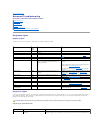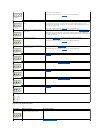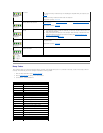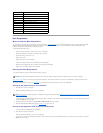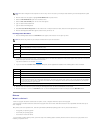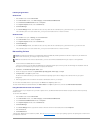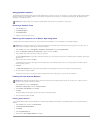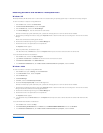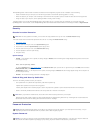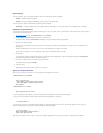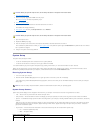
Beep Codes
Your computer might emit a series of beeps that identify a problem. One possible series (code 1-3-1) consists of one beep, a burst of three beeps, and then
one beep. This series tells you that the computer encountered a memory problem.
1. Write the beep code down on the Diagnostic Checklist.
2. Run the Dell Diagnostics to identify a more serious cause.
3. Contact Dell for technical assistance.
error exists.
Verify that the memory modules that you are installing are compatible with your computer (see
"Memory").
Reinstall the memory modules and then restart the computer.
If the problem persists, contact Dell.
A possible system board resource and/or
hardware failure has occurred.
Perform the procedure in "System Board Problems" and see "Resolving Software and Hardware
Incompatibilities."
If the problem persists, contact Dell.
A possible expansion card failure has
occurred.
1. Determine if a conflict exists by removing a card and then restarting the computer.
2. If the problem persists, reinstall the card that you removed, remove a different card, and
then restart the computer.
3. Repeat this process for each card. If the computer starts normally, troubleshoot the last
card removed from the computer for resource conflicts (see "Resolving Software and
Hardware Incompatibilities").
4. If the problem persists, contact Dell.
Other failure has occurred.
Ensure that the cables are properly connected from the hard drive, CD drive, and DVD drive to
the system board.
If the problem persists, contact Dell.
The computer is in a normal operating
condition after POST.
None.
Code
Cause
1-1-2
Microprocessor register failure
1-1-3
NVRAM
1-1-4
ROM BIOS checksum failure
1-2-1
Programmable interval timer
1-2-2
DMA initialization failure
1-2-3
DMA page register read/write failure
1-3
Video Memory Test failure
1-3-1 through 2-4-4
DIMMs not being properly identified or used
3-1-1
Slave DMA register failure
3-1-2
Master DMA register failure
3-1-3
Master interrupt mask register failure
3-1-4
Slave interrupt mask register failure
3-2-2
Interrupt vector loading failure
3-2-4
Keyboard Controller Test failure
3-3-1
NVRAM power loss
3-3-2
NVRAM configuration
3-3-4
Video Memory Test failure
3-4-1
Screen initialization failure
3-4-2
Screen retrace failure
3-4-3
Search for video ROM failure





